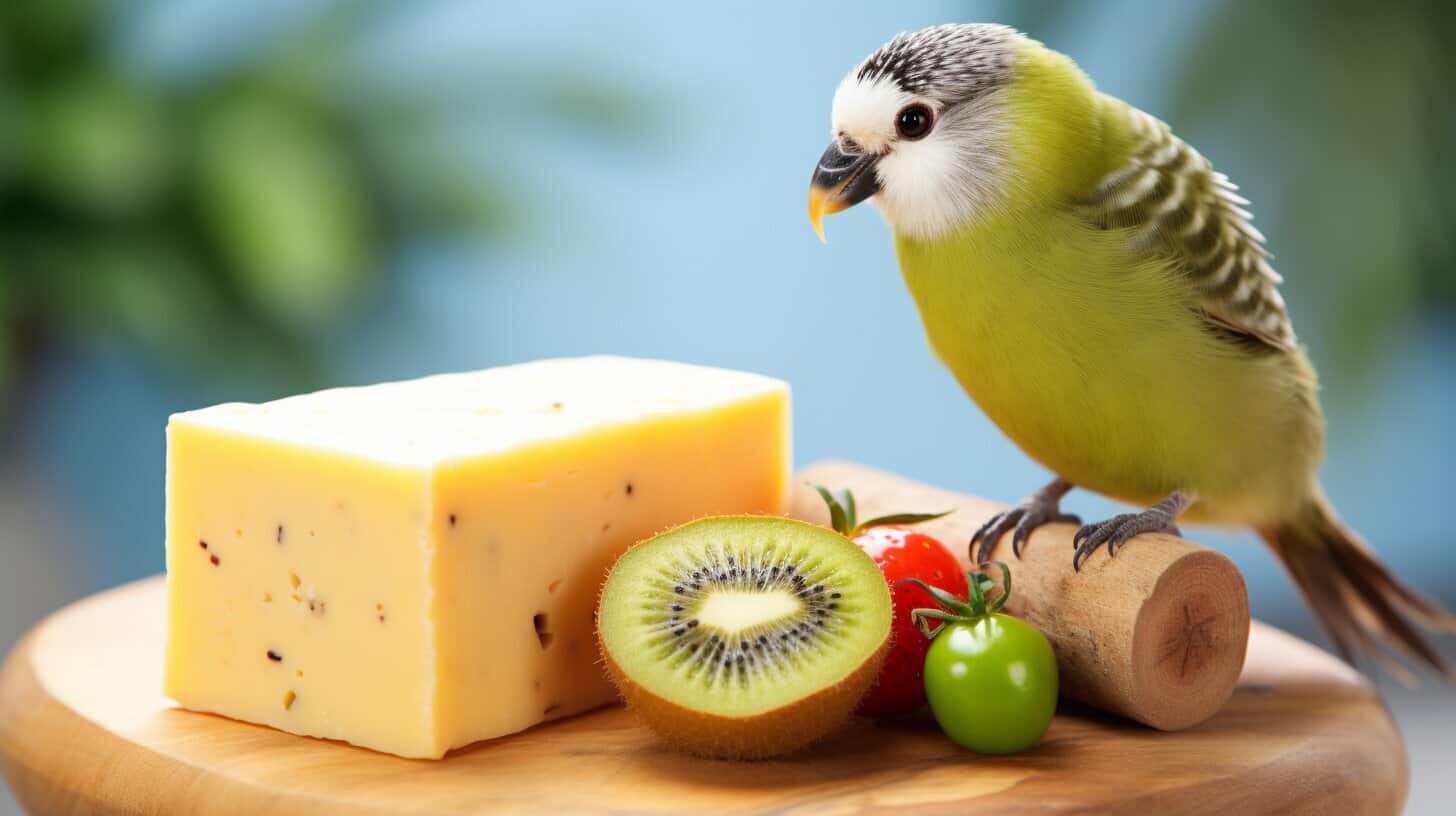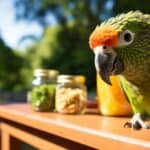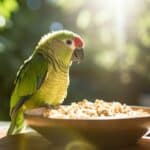If you are a proud kakariki owner, you probably wonder if sharing your favourite cheesy snack with your beloved pet is safe. While cheese may seem harmless, it’s essential to understand the potential risks and benefits of feeding cheese to your kakarikis.
This guide will explore whether kakarikis can safely consume cheese and offer alternative dietary options for these birds. We will also provide recommendations for a healthy and nutritious diet that meets the specific needs of kakarikis, ensuring your feathered friend’s overall health and happiness.
Can kakarikis eat cheese? Kakarikis can consume cheese in small amounts. However, it’s important to give cheese to kakarikis sparingly. Cheese is high in fat and not a natural part of their diet. While a tiny bit occasionally might not be harmful, excessive consumption can lead to digestive problems and unbalanced nutrition. Always monitor their health and consult with a vet for any dietary concerns.
Key Takeaways
- Feeding cheese to kakarikis can pose potential risks such as lactose intolerance, high salt content, and digestive issues.
- A well-balanced and appropriate diet ensures kakarikis’ overall health and happiness.
- Instead of cheese, you can offer various other treats to your kakariki.
- Introducing new foods to kakarikis can require some care and consideration, but ensuring a varied diet is essential.
- Following the recommended diet and incorporating safe alternatives ensures your kakarikis remain happy and healthy companions.
Kakarikis Diet and Nutritional Needs
Kakarikis are a type of parrot native to New Zealand. In the wild, they primarily feed on a diverse diet of fruits, seeds, and insects, providing them with all the necessary nutrients for optimal health. As such, providing them with a balanced diet that meets their nutritional needs is essential.
Protein is an essential component of a kakariki’s diet as it helps support their growth and development, maintains their feathers and skin, and provides them with energy. Good protein sources include seeds, nuts, eggs, and cooked lean meat.
Carbohydrates are also essential for kakarikis as they are a vital energy source. Fruits, vegetables, and whole grains are all good sources of carbohydrates.
Fats are a necessary component of a kakariki’s diet as they help maintain their feathers and skin, regulate their body temperature, and provide long-term energy. Nuts, seeds, and oily fish are good sources of healthy fats.
Kakarikis also require a variety of vitamins and minerals to support their overall health and well-being. Providing them with a diverse diet that contains a mix of fruits, vegetables, whole grains, and protein sources will help ensure they receive all the necessary vitamins and minerals.
It is essential to note that kakarikis should not be fed an all-seed diet as it can lead to nutritional deficiencies and health problems, such as obesity and malnutrition. Instead, aim for a diverse diet that meets your bird’s specific needs.
Cheese and Bird Diet
As a bird owner, you may wonder whether cheese is suitable for your kakariki’s diet. While cheese may be a favourite food for many humans, it is not recommended for birds as part of their regular diet.
Birds have a unique digestive system that does not effectively process dairy products like cheese. Cheese can be high in fat, salt, and lactose, leading to health problems in birds if they consume it regularly.
Feeding your kakariki cheese may also result in digestive issues such as diarrhoea, vomiting, and dehydration, which can harm their health.
“While a small amount of cheese as an occasional treat may not be harmful, it is best to avoid feeding your kakariki cheese as part of their regular diet”
Instead, it is recommended that you provide your kakariki with a balanced diet that meets their nutritional needs. This diet should consist of high-quality pellets, fresh fruits and vegetables, and a small amount of seeds or nuts as a treat.
If you want a tasty treat to offer your kakariki, try fresh fruits like berries, apples, bananas, or vegetables like carrots, broccoli, or sweet potato.
In summary, while cheese may be a human favourite, it is unsuitable as a regular part of your kakariki’s diet. Stick to a balanced diet that meets their nutritional needs and offers occasional treats in small amounts.
Understanding Kakarikis’ Digestive System
Kakarikis have a unique digestive system that requires a specific diet to maintain their health. Unlike mammals, birds have a one-way digestive system, meaning food is processed and eliminated through a single opening called the cloaca.
Their digestive system is highly efficient and can quickly process food, which is necessary for their high energy levels. However, this also means they cannot digest certain foods that humans and other animals can.
Regarding their diet, kakarikis require a diet high in protein and fibre, with minimal fat content. Foods high in fat, such as cheese, can be difficult for them to digest and lead to digestive issues.
When introducing new foods to your kakarikis’ diet, it is important to do so gradually and in small amounts. This will allow their digestive system to adapt to the new food and prevent unexpected issues.
Potential Risks of Feeding Cheese to Kakarikis
If you’re considering adding cheese to your kakariki diet, knowing the potential risks is important. While cheese may seem like a tasty treat for your bird, it can negatively affect its health.
Lactose Intolerance
One of the potential risks of feeding cheese to kakarikis is their lactose intolerance. Many birds, including kakarikis, lack the enzyme lactase, which aids in digesting lactose, a sugar in milk. Consuming cheese and other dairy products can cause digestive issues, such as bloating, diarrhoea and abdominal pain.
High Salt Content
Cheese also has a high salt content, which can harm kakarikis. Too much salt can lead to dehydration, kidney damage and even death. While a small amount of cheese may not pose a significant risk, it’s important to keep salt consumption to a minimum.
Potential Digestive Issues
In addition to lactose intolerance, cheese can cause other digestive issues for kakarikis. The high fat content in cheese can lead to problems such as obesity, fatty liver disease and heart disease. Feeding cheese to your bird can also disrupt their natural digestive process, leading to further health problems.
While cheese may be a tempting treat for your kakarikis, it’s important to consider the potential risks associated with feeding it to your bird. Instead, focus on providing a healthy and balanced diet that meets their nutritional needs.
Benefits of Feeding Cheese to Kakarikis
While cheese doesn’t offer any significant nutritional benefits to kakarikis, it can still be a tasty occasional treat. Cheese is a good source of protein and calcium, which are essential nutrients for birds.
However, it is essential to remember that cheese is also high in fat and salt, which can harm your bird’s health if consumed excessively. Additionally, some kakarikis may be lactose intolerant, so carefully monitoring their reactions to cheese is crucial.
Incorporating cheese into your bird’s diet should be done in moderation. Other treats such as fresh fruits and vegetables, cooked rice or pasta, and small pieces of plain, cooked meats can also be introduced as a part of a balanced diet. Remember to keep the portions small and ensure that these treats don’t make up most of your bird’s daily food intake.
Recommended Diet for Kakarikis
When it comes to the diet of your kakarikis, it is crucial to ensure they receive a well-balanced and nutritious diet. This includes a variety of fruits, vegetables, and protein sources. A balanced diet will help ensure your bird maintains optimal health and longevity.
Here are some recommended foods to include in your kakarikis’ diet:
- Fresh fruits such as apples, berries, and grapes
- Leafy greens such as kale, spinach, and lettuce
- Vegetables such as carrots, sweet potatoes, and broccoli
- Protein sources such as cooked eggs, legumes, and small amounts of chicken or fish
It is important to note that kakarikis have a relatively high metabolism and require frequent access to food. Therefore, it is recommended to provide small amounts throughout the day rather than one or two large meals.
Additionally, while seeds can be incorporated into their diet, they should not be the sole source of nutrition. Seeds are rich in fat and lacking many essential nutrients that birds need to thrive.
Tips for Maintaining a Healthy Diet for Kakarikis
Here are some tips to help maintain a healthy diet for your kakarikis:
- Monitor their weight and overall health regularly
- Provide fresh food and water daily
- Incorporate a variety of fruits, vegetables, and protein sources into their diet
- Limit the number of seeds and unhealthy treats
- Avoid feeding your kakarikis foods that are high in sugar, salt, or fat
By following these recommendations and monitoring their nutritional intake, you can ensure your kakarikis receive a healthy and balanced diet that meets their needs.
Alternative Treats for Kakarikis
If you’re looking to offer your kakarikis a treat without the potential risks of cheese, plenty of safe and healthy options are available. Here are some alternatives to consider:
- Fruits: Kakarikis love fruits, which are rich in vitamins and minerals. Try offering them small amounts of apple, pear, berries, or kiwi as an occasional treat.
- Vegetables: Vegetables are also a great option for kakarikis. Offer them small pieces of carrots, broccoli, spinach, or cucumber, which are rich in fibre and other important nutrients.
- Seeds: Kakarikis enjoy snacking on seeds, which provide essential fatty acids and protein. You can offer them small amounts of sunflower, pumpkin, or sesame seeds as a treat.
- Cooked grains: Cooked grains like rice and quinoa are nutritious and easy to prepare. Offer your kakarikis small amounts of cooked grains as a treat, mixed with some vegetables or seeds.
Remember that treats should only make up a small part of your kakarikis’ diet and not replace their regular meals. Always monitor their intake and adjust their diet to ensure their overall health and well-being.
Introducing New Foods to Kakarikis
Introducing new foods to your kakarikis can be a fun and rewarding experience for you and your feathered friend. However, it is important to do so with care and consideration to avoid any negative reactions or digestive issues.
Start by gradually introducing small quantities of new foods, over a few days or weeks. This will allow your kakarikis to adjust to the new flavours and textures, while minimizing any potential digestive upset.
When introducing new foods, monitoring your kakarikis’ behaviour and health is also important. If you notice any adverse reactions, such as lethargy, vomiting or diarrhoea, remove the new food from their diet and consult your avian veterinarian.
Remember, variety is key in providing a well-balanced diet for your kakarikis. You can offer a range of fresh fruits, vegetables, and healthy snacks to keep your birds happy and healthy.
- Safe fruits for kakarikis include apples, bananas, berries, and melons.
- Vegetables such as broccoli, spinach, carrots, and sweet potatoes are also good options.
- Healthy snack options for kakarikis include unsalted nuts, seeds, and freeze-dried insects.
By introducing new foods gradually and offering a variety of healthy options, you can ensure your kakarikis have a well-balanced diet that provides all the nutrients they need for optimal health and happiness.
Maintaining a Healthy Diet for Kakarikis
To maintain a healthy diet for your kakarikis, it is important to provide them with a balanced and nutritious meals that meet their specific needs. Here are some tips to help you achieve this:
- Offer a variety of fresh fruits and vegetables such as apples, carrots, and spinach to provide essential vitamins and minerals.
- Include small amounts of protein-rich foods in their diet, such as cooked chicken or eggs, to support their muscle growth and development.
- Provide high-quality commercial bird food formulated explicitly for kakarikis, ensuring they get all the essential nutrients they need in the right amounts.
- Limit sugary and high-fat treats such as seeds and nuts, which can lead to obesity and other health issues.
- Monitor their food intake daily to ensure they are consuming an appropriate amount of food.
- Ensure fresh water is always available and change it regularly to prevent bacteria growth.
Providing a well-balanced diet is key to keeping your kakarikis healthy and happy. By incorporating various foods and regularly monitoring their intake, you can ensure they receive adequate nutrition and live their best lives.
Conclusion
In summary, it is natural to want to treat your kakarikis to something different, but feeding them cheese isn’t the way to go. Cheese can be harmful to their health and doesn’t provide any nutritional value. As loving bird owners, it’s essential to understand the specific dietary needs of your pets to ensure their well-being.
While cheese may be off the menu, you can offer plenty of safe and healthy alternatives to your kakarikis. Some examples include fruits, vegetables, seeds, and pellets. Remember that introducing new foods to your birds requires patience and care. Start by offering small portions and gradually increasing as your birds adjust to the new food.
Final Thoughts
Whether you are a new bird owner or have been taking care of kakarikis for years, paying attention to their diet is vital and ensuring they get the nutrition they need. You can keep them in good health and have happy companions for years by providing them with a varied and balanced diet. Remember, moderation, variety, and quality are key to a healthy diet.
FAQ
Q: Can kakarikis eat cheese?
A: Feeding cheese to kakarikis is generally not recommended due to potential risks and lack of nutritional benefits.
Q: What is the recommended diet for kakarikis?
A: Kakarikis require a well-balanced and appropriate diet that meets their needs. A combination of fresh fruits, vegetables, seeds, and pellets is recommended.
Q: Are there any safe treats for kakarikis?
A: Yes, various safe and healthy alternatives to cheese can serve as occasional treats for kakarikis. Some options include small pieces of fresh fruit, vegetables, or bird-safe nuts.
Q: How can I introduce new foods to my kakarikis?
A: Introducing new foods to kakarikis can be done gradually. Start by offering small portions of the new food alongside their regular diet, and monitor their response and digestion.
Q: What are some tips for maintaining a healthy diet for kakarikis?
A: Monitoring their nutritional intake and adjusting their diet as needed is important. Provide a variety of foods to ensure they receive all the essential nutrients and consult a veterinarian for expert advice.



Have comments or questions about this article? Then get involved!
Spotted an error or something we have missed? Let us know